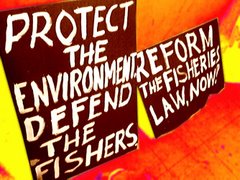Overlooking Tañon Strait, a marine protected area under threat by Japan Petroleum Exploration Co. Ltd. (Japex). Photo by Yowee Gonzales
• A single offshore rig emits the same quantity of air pollution as 7000 cars driving 50 miles per day.
• Routine offshore drilling operations dump thousands of pounds of "drilling muds" (containing heavy metals like cadmium, chromium, arsenic, and lead) into the Gulf of Mexico. The routine pollution can cause severe disruption to marine environments and health and reproductive problems for marine mammals and fish species.
• A single exploratory well dumps approximately 25,000 tons of toxic metals into the ocean.
• A single production platform can have between 50-100 wells and can discharge 90,000 metric tons of drilling fluids, wastes, and metal cuttings into the ocean. *The Gulf of Mexico has a roughly 3000 square mile "Dead Zone" that is growing. Offshore drilling pollution, by smothering benthic (shallow water) communities, contributes to oxygen depletion and adds to the Dead Zone.
• Offshore drilling releases "toxic brines" that are pockets of water that are trapped in the geologic pockets where gas and oil occur. This toxic brine contains NORMS (naturally occurring radioactive materials), cadmium, lead, benzene, etc. The petroleum industry admits that up to 1.5 million barrels of toxic brine are discharged into the Gulf every day.
• In 1982 a 9.6 million gallon spill occurred from a storage tank of coastal Panama. This caused massive damage to seagrass beds, corals, mangroves, and coastal ecosystems much like those occurring Florida. Much of the damage from that spill continued for years, and the lasting impacts are still seen today.
• A single exploratory well dumps approximately 25,000 tons of toxic metals into the ocean.
• A single production platform can have between 50-100 wells and can discharge 90,000 metric tons of drilling fluids, wastes, and metal cuttings into the ocean. *The Gulf of Mexico has a roughly 3000 square mile "Dead Zone" that is growing. Offshore drilling pollution, by smothering benthic (shallow water) communities, contributes to oxygen depletion and adds to the Dead Zone.
• Offshore drilling releases "toxic brines" that are pockets of water that are trapped in the geologic pockets where gas and oil occur. This toxic brine contains NORMS (naturally occurring radioactive materials), cadmium, lead, benzene, etc. The petroleum industry admits that up to 1.5 million barrels of toxic brine are discharged into the Gulf every day.
• In 1982 a 9.6 million gallon spill occurred from a storage tank of coastal Panama. This caused massive damage to seagrass beds, corals, mangroves, and coastal ecosystems much like those occurring Florida. Much of the damage from that spill continued for years, and the lasting impacts are still seen today.






No comments:
Post a Comment